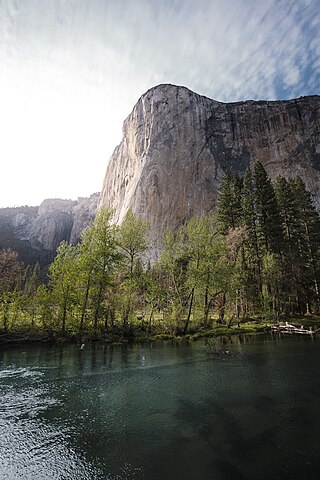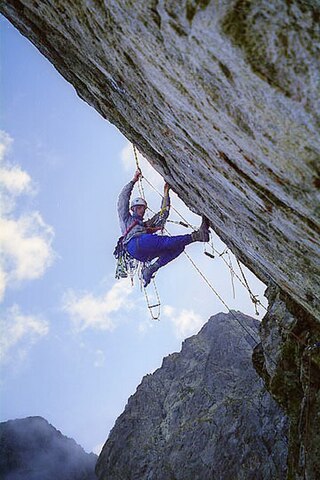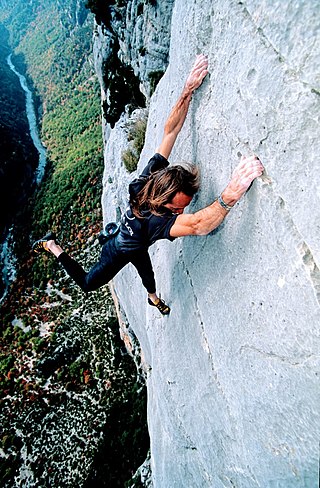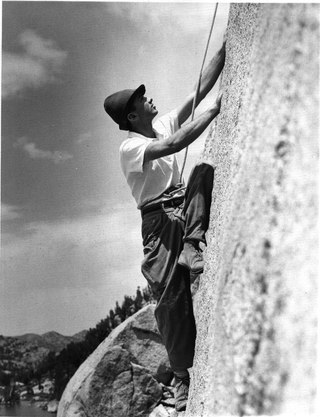
Half Dome is a quartz monzonite batholith at the eastern end of Yosemite Valley in Yosemite National Park, California. It is a well-known rock formation in the park, named for its distinct shape. One side is a sheer face while the other three sides are smooth and round, making it appear like a dome cut in half. It stands at nearly 8,800 feet above sea level and is composed of quartz monzonite, an igneous rock that solidified several thousand feet within the Earth. At its core are the remains of a magma chamber that cooled slowly and crystallized beneath the Earth's surface. The solidified magma chamber was then exposed and cut in half by erosion, therefore leading to the geographic name Half Dome.

Hans Florine is an American rock climber, who holds the record for the number of ascents of Yosemite Valleys El Capitan and is known for holding the speed record on The Nose of Yosemite’s El Capitan 8 different times. Hans' last speed record on The Nose was accomplished with Alex Honnold for climbing The Nose in 2:23:46, on June 17, 2012. In addition to climbing El Capitan over 175 times, Hans also holds the record for the number of ascents of The Nose climbing it more than 111 times.

El Capitan is a vertical rock formation in Yosemite National Park, on the north side of Yosemite Valley, near its western end. The granite monolith is about 3,000 feet (914 m) from base to summit along its tallest face and is a world-famous location for big wall climbing, including the disciplines of aid climbing, free climbing, and more recently for free solo climbing.

Alexander Huber, is a German rock climber who is considered one of the greatest and most influential climbers in the history of rock climbing. Huber came to prominence in the early-1990s as the world's strongest sport climber after the passing of Wolfgang Güllich; he was the second-ever person to redpoint a 9a (5.14d) graded route with his 1992 ascent of Om, and has latterly come to be known as the first-ever person to redpoint a 9a+ (5.15a) graded route with this 1996 ascent of Open Air.

Solo climbing, or soloing, is a style of climbing in which the climber climbs alone, without the assistance of a belayer. By its very nature, it presents a higher degree of risk to the climber, and in some cases, is considered extremely high risk. Note that the use of the term "solo climbing" is generally separate from the action of bouldering, which is itself a form of solo climbing, but with less serious consequences in the case of a fall.

Aid climbing is a form of rock climbing that uses mechanical devices and equipment, such as aiders, for upward momentum. Aid climbing is the opposite of free climbing, which only uses mechanical equipment for protection, but not to assist in upward momentum. "Traditional aid climbing" involves hammering in permanently fixed pitons and bolts, into which aiders are clipped, whereas "clean aid climbing" avoids hammering, and only uses removable placements.

Tommy Caldwell is an American rock climber who has set records in sport climbing, traditional climbing, and in big-wall climbing. Caldwell made the first free ascents of several major routes on El Capitan in Yosemite National Park.

Royal Robbins was one of the pioneers of American rock climbing. After learning to climb at Tahquitz Rock, he went on to make first ascents of many big wall routes in Yosemite. As an early proponent of boltless, pitonless clean climbing, he, along with Yvon Chouinard, was instrumental in changing the climbing culture of the late 1960s and early 1970s by encouraging the use and preservation of the natural features of the rock. He went on to become a well-known kayaker.

Warren Harding was one of the most accomplished and influential American big wall climbers and aid climbers of the 1950s to 1970s. He was the leader of the first team to climb El Capitan, Yosemite Valley, in 1958. The route they climbed, known as The Nose, ascends 2,900 feet (880 m) up the central buttress of what is one of the largest granite monoliths in the world. Harding climbed many other first ascents in Yosemite, some 28 in all, as well as making the first true big-wall ascents in the Sierra Nevada range of California.

Free solo climbing, or free soloing, is a form of rock climbing where the climbers climb solo without ropes or other protective equipment, using only their climbing shoes and their climbing chalk. Free soloing is the most dangerous form of climbing, and, unlike bouldering, free soloists climb above safe heights, where a fall can be fatal. Though many climbers have free soloed climbing grades they are very comfortable on, only a tiny group free solo regularly, and at grades closer to the limit of their abilities.

In mountaineering and climbing, enchainment is climbing two or more mountains or climbing routes on a mountain in one outing. Rock climbing two or more routes in this manner are also called a "link up" in the United States. Climbers may do an enchainment of easy routes as a way of training for a more difficult objective, but some enchainments of hard routes are a prize in their own right, a notable example being the great north faces of the Alps.

In the history of rock climbing, the three main sub-disciplines—bouldering, single-pitch climbing, and big wall climbing—can trace their origins to late 19th-century Europe. Bouldering started in Fontainebleau, and was advanced by Pierre Allain in the 1930s, and John Gill in the 1950s. Big wall climbing started in the Dolomites, and was spread across the Alps in the 1930s by climbers such as Emilio Comici and Riccardo Cassin, and in the 1950s by Walter Bonatti, before reaching Yosemite where it was led in the 1950s to 1970s by climbers such as Royal Robbins. Single-pitch climbing started pre-1900 in both the Lake District and in Saxony, and by the 1970s had spread widely with climbers such as Ron Fawcett (Britain), Bernd Arnold (Germany), Patrick Berhault (France), Ron Kauk and John Bachar (USA).

Dean Spaulding Potter was an American free climber, alpinist, BASE jumper, and highliner. He completed many hard first ascents, free solo ascents, speed ascents, and enchainments in Yosemite National Park and Patagonia. In 2015, he died in a wingsuit flying accident in Yosemite National Park.

Big wall climbing is a form of rock climbing that takes place on long multi-pitch routes that normally require a full day, if not several days, to ascend. Big wall routes are typically sustained and exposed, where the climbers remain suspended from the rock face, even sleeping hanging from the face, with limited options to sit down or escape unless they abseil back down the whole route. It is therefore a physically and mentally demanding form of climbing.

The Nose is a big wall climbing route up El Capitan. Once considered impossible to climb, El Capitan is now the standard for big-wall climbing. It is recognized in the historic climbing text Fifty Classic Climbs of North America and considered a classic around the world.

The Royal Arches Route is a technical climbing route in California's Yosemite Valley on the Royal Arches wall. The route is recognized in the historic climbing text Fifty Classic Climbs of North America. The route was first climbed Oct. 1936 by Ken Adam, Morgan Harris, K. Kenneth Davis. The route is moderate in difficulty and is frequently climbed. The first 4 pitches are along a west facing dihedral. At Pitch 5, the route turns north and ascends the main face along crack systems. Pitch 10 can be free climbed at 5.10b however, most climbers use a fixed rope to pendulum to a long ledge. At the end of Pitch 15, begins the bolted rappel route. It is 18 rappels to the Valley floor. Some climbers prefer to continue to "The Jungle" at the end of Pitch 16. Beyond The Jungle is a 5.4 slab and 4th Class scrambling to the Valley Rim. The descent is usually accomplished by traversing northeast to Washington Column and descending the exposed North Dome Gully.

Charles Marshall Pratt was an American rock climber known for big wall climbing first ascents in Yosemite Valley. He was also a long-time climbing instructor and mountain guide with Exum Mountain Guides in the Grand Tetons.

Alexander Honnold is an American rock climber best known for his free solo ascents of big walls. Honnold rose to worldwide fame in June 2017 when he became the first person to free solo a route on El Capitan in Yosemite National Park, a feat that the New York Times described as "one of the great athletic feats of any kind, ever." Honnold also holds the record for the fastest ascent of the "Yosemite Triple Crown", an 18-hour, 50-minute link-up of Mount Watkins, The Nose, and the Regular Northwest Face of Half Dome. In 2015, he won a Piolet d'Or with Tommy Caldwell for their completion of the enchainment of the Cerro Chaltén Group in Patagonia over 5 days.

Jerry Gallwas is an American rock climber active in the 1950s during the dawn of the Golden Age of Yosemite Rock Climbing. He achieved a number of pioneering first ascents including sandstone spires in the American Southwest, and the first ascent of the Northwest Face of Half Dome with Royal Robbins and Mike Sherrick in 1957. Gallwas made his own heat-treated chrome-molybdenum steel alloy pitons, which contributed to the success of the climb.

Hansjörg Auer was an Austrian mountaineer, noted for his free solo climbs, and particularly of Fish Route in the Italian Dolomites, the first-ever big wall solo at 5.12c (7b+). National Geographic described him as "one of the boldest and best climbers in the world", and he won the 2019 Piolet d'Or for this free solo ascent of the Lupghar Sar West. He died in an avalanche while climbing on Howse Peak in the Canadian Rockies.





















